Sprouting a new future for Wisconsin’s red and white
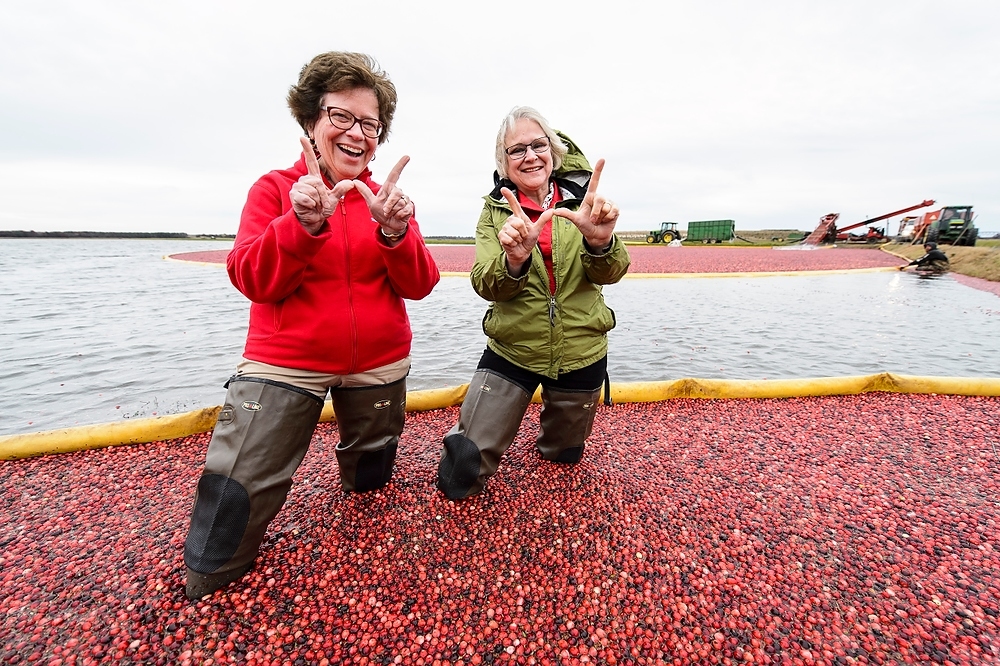
Chancellor Rebecca Blank, left, and Kate VandenBosch, dean of the College of Agricultural and Life Sciences, wade into the knee-deep water of a cranberry marsh as university officials tour farming operations at Cranberry Creek Cranberries, an 850-acre farm owned by Bill and Sandy Hatch in Necedah.
NECEDAH — At a family farm where over 2 percent of the world’s cranberries are grown, Wisconsin’s state fruit sat in two bowls available to guests.
In one bowl, dried cranberries — sweet, wrinkly and gathered in ruby clumps — were an instant crowd pleaser. In the other bowl, fresh berries — tart, firm and in an autumnal variety of deep reds — were an exotic treat.
The fresh berries are a new experimental cultivar called “The Sweetie,” a result of decades of research between cranberry growers and the University of Wisconsin–Madison. Like traditional cultivars, the Sweeties crunch when bitten and are white inside with four hollow chambers that give them buoyancy. But they have a natural sweetness that may unlock new markets or offer clues for future cultivars.
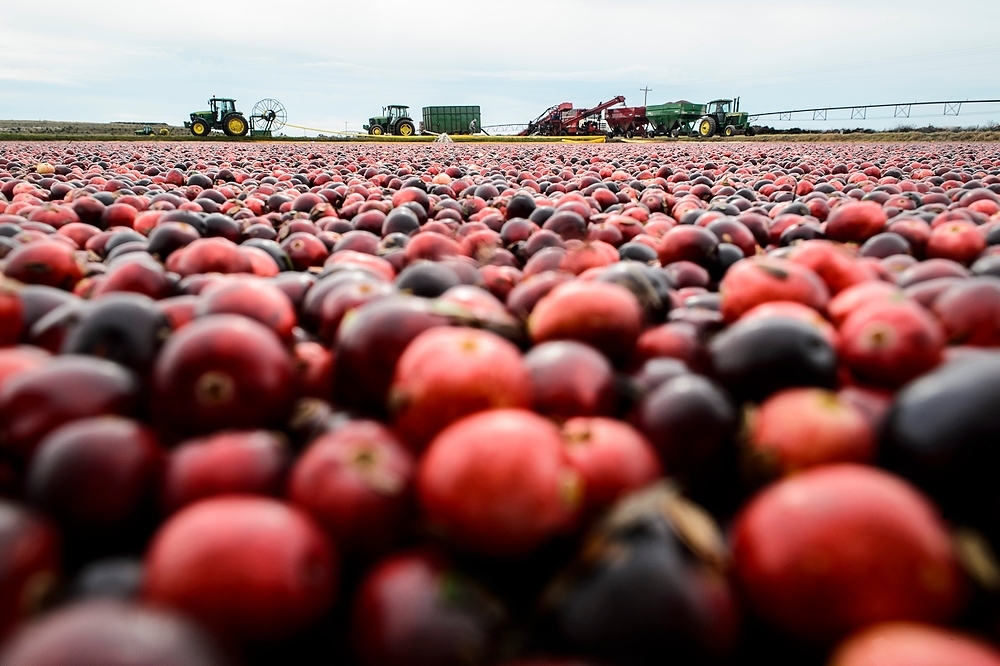
Farmers harvest cranberries from the flooded marsh at Cranberry Creek.
After wading into the harvest at Cranberry Creek Cranberries in Necedah on Tuesday, Chancellor Rebecca Blank sampled the berries and stressed that close partnerships between growers and university researchers sustain the industry in many ways.
Aided by decades of research at UW–Madison, Wisconsin has become the international leader in cranberry production, responsible for approximately 60 percent of the world’s crop.
The Wisconsin Alumni Research Foundation has patented two cultivars — HyRed in 2003 and Sundance in 2011. These, and others in development, offer cranberry growers more effective, sustainable crops.
Like the family farms on which they are grown, the research on cranberry cultivars stretches back decades. Horticulture professor Brent McCown and plant scientist Eric Zeldin (both now emeritus) created about 3,000 unique strains that were run through a series of field trials that eventually produced HyRed, Sundance and others.

Chancellor Rebecca Blank, left, listens to farmers Nicole Hansen and Rocky Biegel describe the traits of a cranberry marsh post harvest.
“We are on our marshes every single day,” says Rocky Biegel, who grows at Dempze Cranberry Co. with his wife, Jamie Dempze Biegel. “We want to do things in a good, environmental way. We live here and we are generational growers.”
Fawn Gottschalk, a grower at Gottschalk Cranberry Inc., told Blank how her family started growing on a bed that was abandoned in 1940, and other growers in the area operate farms that date back to the 1890s.
“We are the stewards for the next generation,” Gottschalk says.
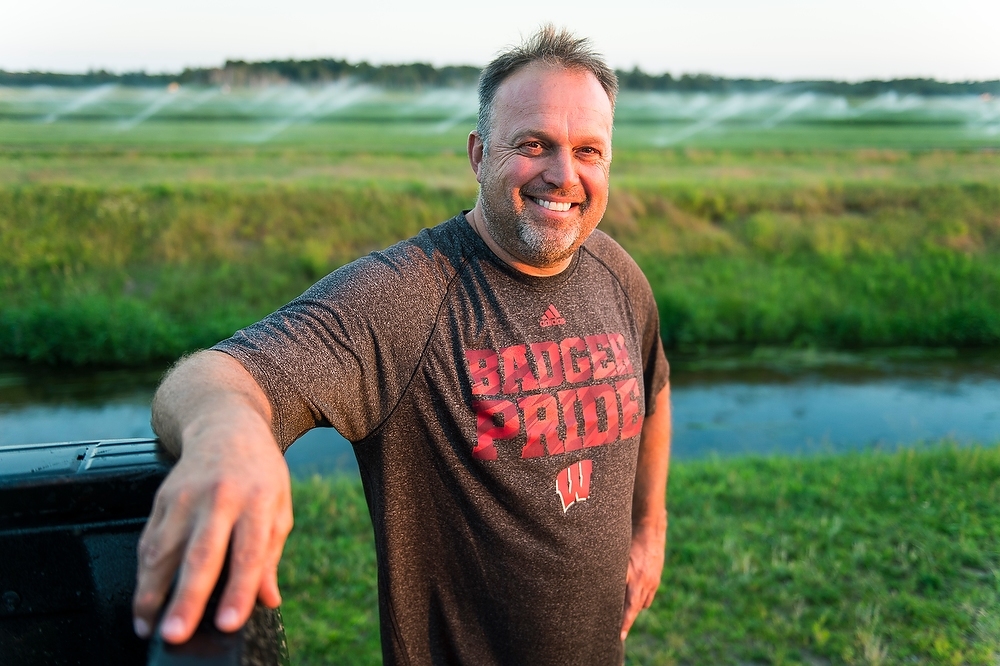
Rocky Biegel looks over mid-season cranberry marshes growing at his 80-acre farm near Wisconsin Rapids in July. Biegel is propagating several productive and profitable cranberry varieties bred at UW–Madison.
Nicole Hansen, the operator at Cranberry Creek, says UW–Madison is a key partner for farmers. She echoes what other growers told Blank — that the impact of university research extends beyond developing cultivars and growing cranberries. Growers also place a high value on studies that analyze the health benefits of consuming cranberries.
On Tuesday, Blank and College of Agricultural and Life Sciences Dean Kate VandenBosch rode in a pickup truck around the rectangular marsh beds of Cranberry Creek’s 850 acres. The berries grow on dense vines that create a mat of vegetation in the marsh beds. They do not grow underwater or in standing water; when they are ripe, the beds are flooded to aid harvest. Harvesters move through the flooded beds and separate the cranberries from the vines. The berries float to the top, where they can be more easily gathered.
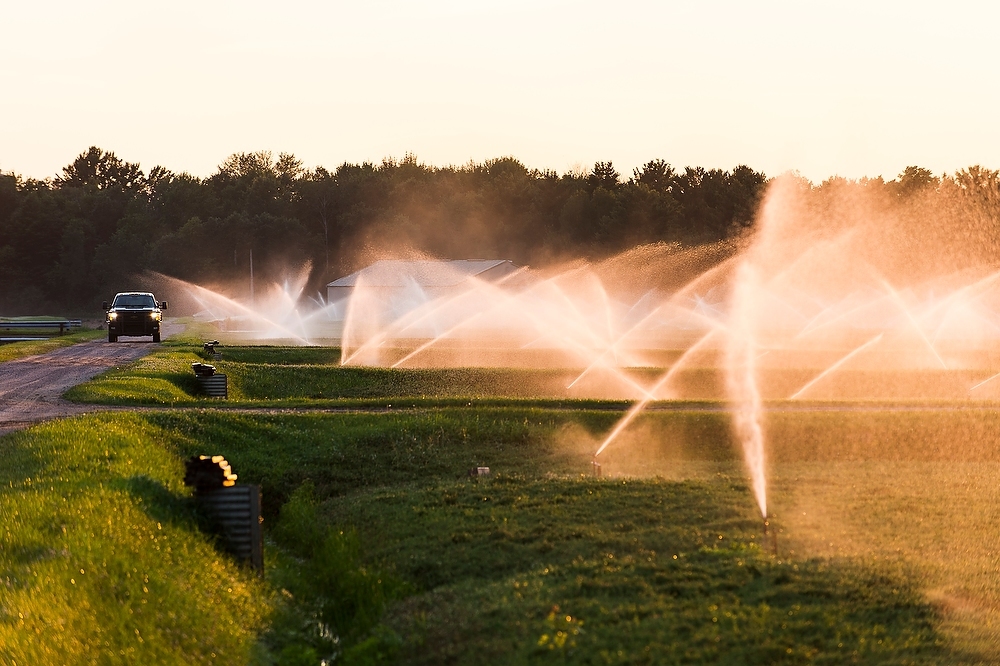
An irrigation system waters cranberry marshes at Dempze Cranberry in July.
It takes several years for new cultivars to be established in a bed, but so far, about 100 acres at Cranberry Creek are producing HyRed cranberries, and a few acres are dedicated to experimental varieties.
In the experimental beds, the vines are grouped into 3-foot squares. The promising cultivars move on to larger experimental beds. It’s a painstaking process, one that takes decades before the results — which can be yields two to three times the state average — take hold.
Only a sliver of the crop, about 3 to 5 percent, is sold as fresh fruit. The harvest used to be contained to a few weeks in October, and the fresh berries appeared at market within a day or two of being harvested. The broader range of cultivars has stretched the harvest from mid-September to late October, but the fresh cranberry is still an ephemeral fall phenomenon. The vast majority of the crop is dried, juiced or used as ingredients in cheeses, sausages and other products.
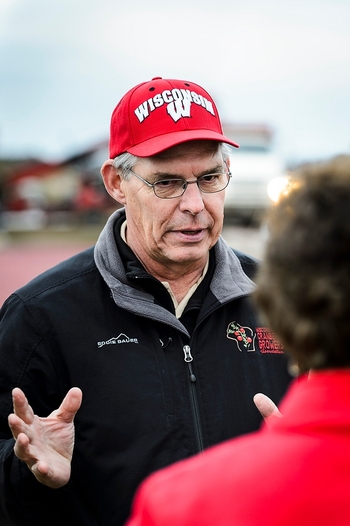
Tom Lochner, executive director of the Wisconsin State Cranberry Growers Association, talks with UW officials during their tour.
The cranberries being collected onto trucks at Cranberry Creek on Tuesday were not headed to the fresh market. As he visited the farm with other growers, Biegel picked a few berries from the water and showed that those destined for the fresh market have to be harvested in a special way to avoid little dents.
“Well, these don’t have any dents,” he said, examining a handful, but dented one with a thumbnail to demonstrate. Then he popped them in his mouth.
He and his wife are the fourth generation in her family to grow cranberries, and their daughter, Rochelle, and her husband, Nick Hoffman, operate a marsh in west central Wisconsin that propagates UW–Madison cranberry cultivars for sale to other growers.
And the red and white of cranberries flow through their family in other ways: Both of their sons are Badger football players. Hayden, a sophomore, is an offensive lineman and Vincent, a redshirt junior, is a linebacker.
“This is about sustainable farming,” Biegel says. “It’s about taking care of these fields for the next generation, about taking care of what you have: the wildlife, the soil, and the plants that will keep producing year after year.”
—David Tenenbaum and Lee Sensenbrenner
Subscribe to Wisconsin Ideas
Want more stories of the Wisconsin Idea in action? Sign-up for our monthly e-newsletter highlighting how Badgers are taking their education and research beyond the boundaries of the classroom to improve lives.
Tags: agriculture, business, outreach, research, The Wisconsin Idea




